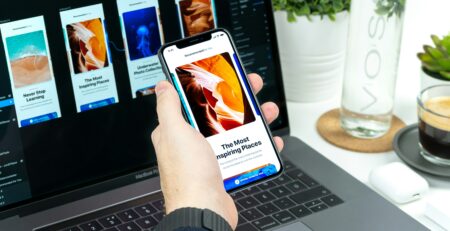Why We Need Service Design
Services provide a user experience just as much as traditional goods do. The line between the two has been blurring in recent decades because of new combinations of internet services and concrete goods. For example, a food delivery app is providing a transportation service but the food being delivered is a significant part of the end user’s experience.
The degree to which streaming services, cloud-based software, and other SaaP companies have separated the idea of consumption from the delivery of concrete goods and from ownership has made service industries even more important.
Navigating the nebulous difference between service design and product design is challenging for many companies, which creates an imbalance in experience design theory. Businesses must consider the entire scope of their users’ and customers’ experiences. To find out all you need to know about service design so your company can stay on the cutting edge, read through this guide.
Service Design vs. Experience Design
There is a considerable amount of overlap between UX and service design, understandably creating some confusion. However, some things are exclusive to service design. Additionally, considering service in its own right will help mold a more balanced approach to the entire production process.
A great example of UX design and service design overlap is a rideshare app. The app itself needs UI design and the overall experience of the user from the time they open the app to the time they close it must be great if you want them to return.
But once the user is in the car, there is a customer-facing service being rendered. UX designers can build a flawless app and use algorithms to call the closest cars to the user but they’ll be missing out on a crucial piece of the puzzle if they don’t also build elements that encourage courteous behavior from the driver and make sure the car itself is comfortable for the rider.
Experience design operates on a qualitative level that is similar to the kind used in UX design but isn’t exactly the same. There is no call to action like you might see on a website or app design, unless you collect user reviews.
In the case of rideshare apps, the service design is at least 50% of the product. Neglecting it would be a fatal mistake for any company with hopes of creating the ideal user experience.

Where Does Service Design Fit In?
UX design blends design and business concerns with user pain points while experience design seeks to incorporate the quality of service and customer enjoyment with the business process. Both are required to build a product or service that appeals.
But where exactly would you implement service design? Is it only in customer-facing instances like cash registers and in transit on buses, cars, or planes?
The central goal of service design is a holistic experience for the user. In some sense, it is an addition to the central tenets of UX design thinking. It can be implemented at many stages in a given business process depending on who is viewed as the user or to whom the service is being rendered.
For example, HR could be seen as providing a service to employees who would then be the user. The same way a UX designer might build a stellar app or employee portal to streamline things and improve the overall experience, so too could service design be used to build better physical spaces and provide HR employees with the resources they need to give the end-user employees a better experience.
Sometimes service design involves a physical product even though that isn’t what the customer is buying. When you buy an airplane ticket, for instance, you are only paying to be flown somewhere. Service design would nonetheless center around the quality of physical things like the airport and airline as well as some digital aspects like the booking site.
Measuring Success of Service Design Thinking
Like UX design bases its metrics of success on user research, engagement, and satisfaction, service design thinking must measure the length of the customer-company relationship, how much effort customers will put into engaging services, and how much it costs to provide services to customers.
You don’t need all of these metrics for every single project or even company, but some of them are incredibly valuable for most companies. Those that help predict what changes need to be made or give a true reflection of the impact of current services are very helpful when planning for changes that will need to be made in the future. Without at least some of these metrics in place, you not only won’t know how successful your projects have been but you could also miss problems with rollout or runaway expenditures that weren’t caught elsewhere.
One common method for measuring the more qualitative aspects of a service experience is sending out electronic surveys after the fact. These may be more successful as direct emails to people who have used a service recently, although sending them out over social media platforms could be successful as well.
Research about preferences could also be useful, although not quite to the extent that it would be in UX design. Since you’re targeting a much more specific service that could be totally unique to your company, gathering information about general experience might not be as valuable, particularly when you’re dealing with internal business processes.
Service design is all about the impact of the service. You don’t need speculative hypothetical opinions in the research – you need direct feedback on the services you provide and how the customer experienced them.
Cost-to-serve, or CTS, is one of the most important metrics for business-minded people trying to incorporate service design thinking into their company practices. If it’s not worth the money you spend on it, then the service has no reason to continue.
It’s also possible for a service to seem superfluous, unneeded, or out of place to a customer. Regardless of how good it is, it may not appeal in the context of your other goods and services. As an exaggerated example, it wouldn’t make sense to offer discounts on tennis shoes at a bowling alley.
Benefits of Service Design
There are many reasons you should be including service design in your business processes if you haven’t already started doing so. Here are a few of the most important reasons.
1. Build Customer Loyalty
UX design will build a better product that people will love more and service design will create a service that people will continuously return to. This is doubly so if the service is effective, consistent, enjoyable, reasonably priced, and intuitive.
In some cases, convenience alone brought people to the service. When smartphone apps caused a wide swath of delivery and rideshare services to flourish, it seemed there would be no end. But convenience and novelty alone didn’t suffice for some companies which have since folded.
It’s vital to keep improving on the services you offer while still maintaining enough similarities that people will associate the experience with your brand when they think back on it. If you can hit that innovative stride just right, people will become loyal to your service not only for its continued enjoyability, but for its ability to provide the same great experience no matter how the actual service changes or improves.
As long as you have a process in place to constantly and consistently monitor the overall response to and enjoyment of the service you provide, you should be able to escape the trend and become a cornerstone of the service in your own right.
Customer and brand loyalty is something most companies view as a magic bullet. Once you’ve established this mythic thing called brand loyalty, you just have to maintain and that customer base will stay with you.
But the definition of customer loyalty by business leaders and thinkers has given the concept more power than it might have. Brand loyalty happens in the moments where people make a decision about which product or service to buy. Usually, when selecting services they will go with the brand they trust, but if there is either a reason to doubt that trust or a novel appeal from another company, that loyalty may not pay out.
Using service design thinking, you can more accurately find out what the customers want. That will combine the trust of brand loyalty with the immediate appeal of novelty to persuade people to stick with your company’s services for the long term.
2. The Whole Business Is More Holistic
Concentrating on the final service renders the organization more effective because people in different departments will be examining the total process and their role within it. Seeing the process as if they were looking at it from the outside will help employees prioritize more effectively and prevent them from fixating on insignificant details.
Divisions between departments into what are commonly referred to as silos will more than likely be abandoned. While there may be different sections where employees are specifically trained to accomplish certain purposes, they are more likely to communicate and have some idea of what other departments are doing.
This has many benefits, including a more open workplace and better culture overall. The business will be more effective and streamlined, perhaps even able to shed outside parties by insourcing once silos have more or less broken down.
When people across the business are aware of what’s happening in other departments, they have a more holistic view of the company itself. As long as that matches the mission statement established by management, all the employees will be able to see their individual place in the overall business process. This typically makes them feel more at home in their role and makes them stay longer and work harder there because it means something to them personally.
3. More Successful Innovation
New products and services are more likely to succeed if you have put in the work to define current service experiences and how effective they are. You can fix things where they seem to be lacking and you can also discover new services or features that don’t exist yet. If you aren’t looking for them, they usually don’t appear out of nowhere unless it’s because the competition has beat you to a new idea and rolled it out successfully.
The risk is reduced in some ways when you invest in service design. Since you know more about what makes the service work and what doesn’t, building a new service or product with this information should calm stakeholders who are on board with the service design thinking being used in a given project.
When you combine UX with service design thinking then innovation is even more likely to be successful. User research with the aim of including the user in the design of the product reduces mistaken perceptions about who users are and what they need. This makes for a better product that they will enjoy more. Service design does the same thing with services.
4. Stay Competitive
Technology, the internet and more broad societal trend shifts are changing the way we think about service. It’s no longer the realm of restaurants and airplanes alone. The internet has erased some aspect of ownership that caused us to think about the majority of purchases as being directly tied to products. In some cases, digital products are a service.
None of this is happening quietly in the background. The most successful companies have tapped into this trend and adjusted their business practices to it. If your business can’t use service design thinking to offer its customers services that can compete, it’s bound to be left behind.
From another perspective, your business can get a great jump on the competition if service design thinking is implemented early enough and leads to bold ideas that are invested in and brought to fruition. Who knows how many novel services and ways to provide existing services there are, especially with the advent of impressive new technology like artificial intelligence and augmented reality.
5. Builds a More Customer-Centric Organization
Design-driven organizations are more flexible, agile, and effective at building products and services that their customers and users want. That’s because they take the time to get into the minds of people who will engage their services.
When service design is readily apparent in a few key places of the organization, it’s probably going to spread to other departments and get used in more innovative ways. People like this approach because it makes intuitive sense. If it’s getting good results, others in the company are going to want to emulate it in their roles as well.
Service Design Thinking & Operations Management
Operations management is the organization of goods, services, resources, and production within the operations of a company. If you can effectively apply service design to internal processes that employees face daily, you’ll also be building a great company atmosphere and improving your employer branding.
When you hear designers and innovators speak about a holistic process, this is what they mean. Service design bolsters your company brand, employee retention, product and service appeal, and may even be able to streamline production and delivery processes.
In many areas of logistics, which falls firmly under the umbrella of operations management, treating sources and perks as services your company renders to upstream suppliers helps construct the correct approach to make the deal when needed and try to bargain the best price when you’re buying raw materials and components.
It also helps put the scope of operations management work into perspective. Rather than trying to present every operations management worker as changing the world completely, onboarding and training agents can demonstrate how their work enables the company to render a needed service. The impacts of that service can make operations management employees see the effects of their work and inspire them to stay longer in their role and work harder in it.

Conclusion:
Service design is incredibly important in today’s world. The line between product and service is being marred little by little. In many cases, people are no longer paying for ownership, preferring rideshares to buying cars. The idea of rendering products as a service is growing in popularity for many industry leaders and designers would do well to prepare for that by incorporating service design into their practice.












